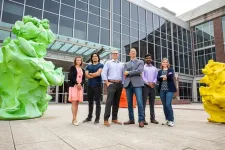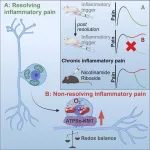(Press-News.org) Scientists have engineered a chromosome entirely from scratch that will contribute to the production of the world’s first synthetic yeast.
Researchers in the Manchester Institute of Biotechnology (MIB) at The University of Manchester have created the tRNA Neochromosome – a chromosome that is new to nature.
It forms part of a wider project (Sc2.0) that has now successfully synthesised all 16 native chromosomes in Saccharomyces cerevisiae, common baker’s yeast, and aims to combine them to form a fully synthetic cell.
The international team has already combined six and a half synthetic chromosomes in a functional cell. It is the first time scientists have written a eukaryotic genome from scratch.
Yeasts are a common workhorse of industrial biotechnological processes as they allow valuable chemicals to be produced more efficiently, economically, and sustainably. They are often used in the production of biofuels, pharmaceuticals, flavours and fragrances, as well as in the more well-known fermentation processes of bread-making and beer-brewing.
Being able to re-write a yeast genome from scratch could create a strain that is stronger, works faster, is more tolerant to harsh conditions and has a higher yield.
The process also sheds light on the traditionally problematic genome fundamentals, such as how genomes are organised and evolved.
The findings of both projects, published as two research articles of the prestigious journals Cell and Cell Genomics respectively, are a culmination of 10 years of research from an international consortium of scientists led by Professor Patrick Cai and The University of Manchester, and mark a new chapter in engineering biology.
The University of Manchester’s research also features on the front covers of both journals.
Prof Cai, Chair in Synthetic Genomics at The University of Manchester who is the international coordinator of Sc2.0 project, said: “This is an exciting milestone when it comes to engineering biology. While we have been able to edit genes for some time, we have never before been able to write a eukaryote genome from scratch. This work is fundamental to our understanding of the building blocks of life and has the potential to revolutionise synthetic biology which is fitting as Manchester is the home of the Industrial Revolution. Now, we’re at the forefront of the biotechnological revolution too.
“What’s remarkable about this project is the sheer scale of collaboration and the interdisciplinarity involved in bringing it to fruition. We’ve brought together not only our experts here in the MIB, but also experts from across the world in fields ranging from biology and genomics to computer science and bioengineering.
Dr Daniel Schindler, one of the two lead authors and group leader at the Max Planck Institute for Terrestrial Microbiology and the Center for Synthetic Microbiology (SYNMIKRO) in Marburg, added: "The international Sc2.0 is a fascinating, highly interdisciplinary project. It combines basic research to expand our understanding of genome fundamentals, but also paves the way for future applications in biotechnology and drives technology developments.
“The international and inclusive nature of the project has unleashed the science and seeded future collaborations and friendships. The Manchester Institute of Biotechnology, with its excellent research environment and open space, has always facilitated this."
The tRNA neochromosome is used to house and organise all 275 nuclear tRNA genes from the yeast and will eventually be added to the fully synthetic yeast where the tRNA genes have been removed from the other synthesised chromosomes.
Unlike the other synthetic chromosomes of the Sc2.0 project, the tRNA neochromosome has no native counterpart in the yeast genome.
It was designed using AI assisted, computer-assisted design (CAD), manufactured with state-of-the-art roboticized foundries, and completed by comprehensive genome-wide metrology to ensure the high fitness of the synthetic cells.
Next, the researchers will work together to bring all the individual synthetic chromosomes together into a fully synthetic genome. The final Sc2.0 strain will not only be the world’s first synthetic eukaryote, but also the first one to be built by the international community.
“The potential benefits of this research are universal – the limiting factor isn’t the technology, it’s our imagination”, says Prof Cai.
END
Scientists one step closer to re-writing world’s first synthetic yeast genome, unravelling the fundamental building blocks of life
2023-11-08
ELSE PRESS RELEASES FROM THIS DATE:
Scientists take major step towards completing the world’s first synthetic yeast.
2023-11-08
A UK-based team of Scientists, led by experts from the University of Nottingham and Imperial College London, have completed construction of a synthetic chromosome as part of a major international project to build the world’s first synthetic yeast genome.
The work, which is published in Cell Genomics, represents completion of one of the 16 chromosomes of the yeast genome by the UK team, which is part of the biggest project ever in synthetic biology; the international synthetic yeast genome collaboration.
The collaboration, known as 'Sc2.0' has been a 15-year project involving teams from around the world (UK, US, China, Singapore, UK, France and Australia), working together ...
New antifungal molecule kills fungi without toxicity in human cells, mice
2023-11-08
CHAMPAIGN, Ill. — A new antifungal molecule, devised by tweaking the structure of prominent antifungal drug Amphotericin B, has the potential to harness the drug’s power against fungal infections while doing away with its toxicity, researchers at the University of Illinois Urbana-Champaign and collaborators at the University of Wisconsin-Madison report in the journal Nature.
Amphotericin B, a naturally occurring small molecule produced by bacteria, is a drug used as a last resort to treat fungal infections. While AmB excels at killing fungi, it is reserved ...
Cellular “atlas” built to guide precision medicine treatment of rheumatoid arthritis
2023-11-08
Research consortium investigators analyzed over 314,000 cells from rheumatoid arthritis tissue, defining six types of inflammation involving diverse cell types and disease pathways
Understanding the disease at single-cell level may advance targeted drug development and treatment strategies
Rheumatoid arthritis (RA) is an autoimmune disease characterized by inflammation that leads to pain, joint damage, and disability, which affects approximately 18 million people worldwide. While RA therapies targeted to specific inflammatory pathways have emerged, only some patients’ symptoms improve with treatment, emphasizing the need for multiple ...
Estimated effectiveness of co-administration of the Pfizer-BioNTech COVID-19 vaccine with influenza vaccine
2023-11-08
About The Study: In this study that included 3.4 million adults, co-administration of the BNT162b2 BA.4/5 bivalent mRNA COVID-19 vaccine (Pfizer-BioNTech) and seasonal influenza vaccine was associated with generally similar effectiveness in the community setting against COVID-19–related and seasonal influenza vaccine-related outcomes compared with giving each vaccine alone and may help improve uptake of both vaccines.
Authors: Leah J. McGrath, Ph.D., of Pfizer Inc., in New York, is the corresponding author.
To ...
Age at diagnosis of atrial fibrillation and incident dementia
2023-11-08
About The Study: Earlier onset of atrial fibrillation was associated with an elevated risk of subsequent all-cause dementia, Alzheimer disease, and vascular dementia in this study including 433,000 UK Biobank participants, highlighting the importance of monitoring cognitive function among patients with atrial fibrillation, especially those younger than 65 years at diagnosis.
Authors: Fanfan Zheng, Ph.D., of the Chinese Academy of Medical Sciences & Peking Union Medical College in Beijing, and Wuxiang Xie, Ph.D., of the Peking University First ...
Physicists trap electrons in a 3D crystal for the first time
2023-11-08
Electrons move through a conducting material like commuters at the height of Manhattan rush hour. The charged particles may jostle and bump against each other, but for the most part they’re unconcerned with other electrons as they hurtle forward, each with their own energy.
But when a material’s electrons are trapped together, they can settle into the exact same energy state and start to behave as one. This collective, zombie-like state is what’s known in physics as an electronic “flat band,” and scientists predict that when electrons are in this state they can start to ...
Scaling up nano for sustainable manufacturing
2023-11-08
A new self-assembling nanosheet could radically accelerate the development of functional and sustainable nanomaterials for electronics, energy storage, health and safety, and more.
Developed by a team led by Lawrence Berkeley National Laboratory (Berkeley Lab), the new self-assembling nanosheet could significantly extend the shelf life of consumer products. And because the new material is recyclable, it could also enable a sustainable manufacturing approach that keeps single-use packaging and electronics out of landfills.
The ...
Validating the role of inhibitory interneurons in memory
2023-11-08
Memory, a fundamental tool for our survival, is closely linked with how we encode, recall, and respond to external stimuli. Over the past decade, extensive research has focused on memory-encoding cells, known as engram cells, and their synaptic connections. Most of this research has centered on excitatory neurons and the neurotransmitter glutamate, emphasizing their interaction between specific brain regions.
To expand the understanding of memory, a research team led by KAANG Bong-Kiun (Seoul National University, Institute ...
Scientists tame biological trigger of deadly Huntington’s disease
2023-11-08
Huntington’s disease causes involuntary movements and dementia, has no cure, and is fatal. For the first time, UC Riverside scientists have shown they can slow its progression in flies and worms, opening the door to human treatments.
Key to understanding these advancements is the way that genetic information in cells is converted from DNA into RNA, and then into proteins. DNA is composed of chemicals called nucleotides: adenine (A), thymine (T), guanine (G), and cytosine (C). The order of these nucleotides determines what biological instructions are contained in a strand of DNA.
On occasion, some DNA nucleotides repeat themselves, ...
Disturbances in sensory neurons may alter transient pain into chronic pain
2023-11-08
Utrecht, November 8, 2023 - Researchers from the Center for Translational Immunology at University Medical Center Utrecht (the Netherlands) have identified that a transient inflammatory pain causes mitochondrial and redox changes in sensory neurons that persist beyond pain resolution. These changes appear to predispose to a failure in resolution of pain caused by a subsequent inflammation. Additionally, targeting the cellular redox balance prevents and treats chronic inflammatory pain in rodents.
Pain often persists in patients with an ...





